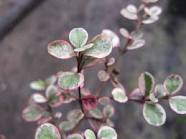Pittosporum
These are small trees or large shrubs that vary a great deal in their leaves and flowers. Some kinds have pretty foliage and others have very fragrant flowers. They are a common sight in the native vegetation of New Zealand and Australia, but some are found wild in China and other countries. Many kinds can be grown outside in the U.S. in mild areas. Some are perfect for growing in tubs or pots. A few kinds are good hedge plants, especially in seaside gardens. A few, such as, P. eugenioides, P. colensoi and P. tenuifolium are useful for use in floral arrangements. Possibly, the hardiest kind is P. tenuifolium. This native of New Zealand can form a tree 30 feet high with a dark-colored trunk up to a foot around. It has black or purplish shoots covered with shiny, light green leaves that are 1 to 1� inches long and have wavy edges. The dark purple flowers are usually produced singly from the leaf axils in May. The variety Silver Queen has lovely silver leaves. P. crassifolium is a large shrub, 12-18 feet tall, with tough, thick leaves that are dark green above and covered with thick grayish fuzz underneath. The leaves grow 4 inches long and 1� inches wide. The flowers are dull purple and are produced in May in small, thick clusters at the ends of the shoots. P. pauciflorum is from China. It can grow 4-6 feet high and its leaves form small clusters at the ends of the shoots. It bears fragrant, yellowish flowers in May. P. tobira is one of the most beautiful kinds from China and Japan. It can grow up to 20 feet high in its native country. The thick, dark green, leathery leaves are up to 4 inches long and 1� inches wide. The flowers grow in thick clusters at the ends of the shoots. They're white when they first open, but as they age, turn yellow. They are very fragrant and remind people of orange blossoms.
Pot Cultivation
These plants grow best in ordinary, well-drained, loamy soil, or in almost any garden soil where the climate is suitable. They'll grow into well-shaped bushes with little attention. What little pruning is necessary should be carried out in the summer. They are mainly grown for their foliage rather than flowers, but a few kinds are grown for both benefits.
Propagation
Cuttings of half-ripe shoots that are about 4-5 inches long, can be taken with a slight 'heel' of wood in July and placed in a propagating case or a cold frame in a greenhouse. They root easily. Those that have been placed in a cold frame shouldn't be disturbed until the following spring. Once they have grown roots, they can be planted singly and kept in a cold frame until they can be planted in their permanent places, or they can be planted in a nursery border.
 |
|
| P. ralphii |
|
VARIETIES
- P. bicolor;
- P. Buchananii;
- P. ferrugineum;
- P. heterophyllum;
- P. rhombifolium (Queensland P.);
- P. pentandrum (willow-leaved P.);
- P. odoratissimum (Fragrant P.);
- P. ralphii;
- P. eugenioides;
- P. colensoi;
- P. tenuifolium;
- P. crassifolium;
- P.pauciflorum;
- P. undulatum;
- P. Tobira.





